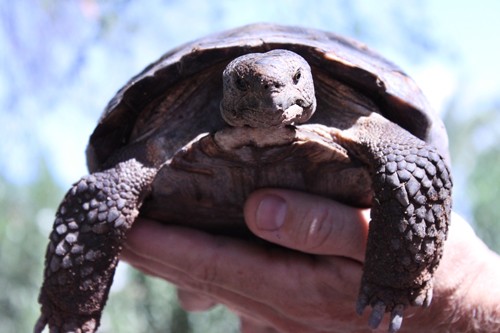A recent petition to place the Sonoran desert tortoise on the Endangered Species List has some experts saying environmentalists are getting too overeager.
The Sonoran tortoise population is a sub-group of the free-ranging desert tortoise, and is found southeast of the Colorado River and all the way down to Mexico.
The other sub-group of the desert tortoise is known as the Mojave Desert population, which is found northwest of the Colorado River. The Mojave population was listed under the Endangered Species Act after researchers found massive declines associated with disease and habitat destruction in the 1990s.
In October 2008, two conservation groups submitted a petition urging the U.S. Fish and Wildlife Service to list the Sonoran population under the Endangered Species Act, along with the already listed Mojave population.
The two environmentalist groups, the Wild Earth Guardians and the Western Watersheds Project, believe the Sonoran populations are just in as grave of danger.
“”From the data that we supplied to the U.S. Wildlife Service, there has been a 50 percent decrease in the Sonoran desert population since 1990,”” said Dr. Michael Conner, the California director for the Western Watersheds Project and one of the authors for the petition. “”We have monitored data since the Mojave Desert population was placed on the Endangered Species List. Since that time they have decreased 3 percent per year.””
Under the protection of the Endangered Species Act, scientists would create a recovery plan for the tortoise that would specify which habitats are most vulnerable and issue laws that will protect them from destruction, as well as allot more money for research, Connor said.
Taylor Edwards, assistant staff specialist at the Arizona Research Laboratories, said although the Sonoran populations have suffered loss in numbers, they are not quite in the same boat as the Mojave population.
“”I do not think that it is proper usage of the Endangered Species Act,”” said Edwards. “”To me there are a lot of other species that warrant protection in the Sonoran desert that are not currently listed.””
Edwards said the placement of the Sonoran desert tortoise on the endangered species list will pull government funds away from other vulnerable species.
“”I would rather see our efforts and financial resources go toward these other species; I do not think tortoises in the Sonoran Desert are on the verge of extinction,”” Edwards said.
However, Phil Rosen, a research scientist from the school of natural resources and environment, said just the opposite.
“”Although I don’t think the Sonoran population is nearly as threatened as the Mojave, it needs to get more research focus than it has,”” he said. “”Funding for the Mojave population will not decline if the Sonoran population is listed, but funding for the Sonoran population will go up.””
Edwards cited the Sonoran’s current state protection as another reason why the population does not need to be listed under the Endangered Species Act.
“”I think our state laws are adequately protecting tortoises, and in conservation we need to make choices — we can’t list everything under the Endangered Species Act,”” Edwards said.
Rosen offered a different argument.
“”Existing protection under state law in Arizona is largely toothless in regard to the most critical threats facing the tortoise,”” he said. “”State law merely prohibits collecting tortoises from the wild, an important but insufficient regulation. Only the Endangered Species Act offers the possibility of real protection.””
Although there are some discrepancies between researchers, all experts agree on the fact that the there has not been significant research on Sonoran desert tortoise populations in the past — and that conflicts with their potential to warrant federal protection.
“”We need to know more about them to make good conservation decisions,”” Edwards said. “”Two-thirds of the population is in Mexico!””
Connor and Rosen said the main point of submitting the petition was to increase research funds so scientists can learn more about the Sonoran desert tortoise.
“”The listing of the desert tortoise in Arizona would do a tremendous amount of good in preserving habitat for thousands of species and keeping open space in which people can recreate and grow intellectually,”” Rosen said.
The two groups will find out whether they have warranted the Sonoran desert tortoise federal protection sometime next month. If the U.S. Fish and Wildlife Service finds the Sonoran desert tortoise has met all the criteria to be listed under the Endangered Species Act, it will immediately begin building a framework for a recovery plan, Connor said.









